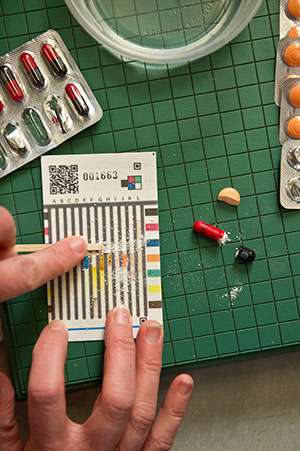Researchers put chemistry lab on paper to detect low-quality medicine

(Phys.org) —Marya Lieberman, associate professor of chemistry and biochemistry at the University of Notre Dame, and her collaborators have recently published results that show the effectiveness of an inexpensive paper test card that could fundamentally change the balance of power between pharmaceutical buyers and sellers in the developing world.
When you buy fruit, you can easily judge whether the fruit is ripe or rotten. But when you buy medicine, you have to trust the seller that the pills are high quality rather than low quality. In the developed world, regulatory systems and technological infrastructure help to keep low-quality pharmaceuticals off the shelves. But in the developing world, low-quality medicines that contain the wrong drug or no drug at all are a growing danger.
Lieberman and her collaborators at the University of Notre Dame and Saint Mary's College have recently published work in the journal Analytical Chemistry that shows an inexpensive way to distinguish substitutes or diluted drugs from real medicines used to treat common bacterial infections and tuberculosis.
The group devised a lab on a piece of paper that an ordinary person can use to see if what's inside a drug tablet matches the label. The user swipes the tablet across the test card, which scrapes off small amounts of the drug material in several test regions, then dips the bottom edge of the paper into water. As the water wicks up the paper, it mixes chemicals stored in the paper with the drug sample. The test results appear as a color bar code that looks different for different drug ingredients.
The paper test cards detect different types of antibiotics and anti-tuberculosis medications. The tests also screen for materials such as flour or chalk that counterfeiters may use to dilute real drugs, and detect inexpensive drugs such as acetaminophen that may be used as substitutes for more expensive medications.
Since the test cards cost only a few cents, many buyers can use them to test medicine before purchase. The threat that someone may check the medication may be enough to induce careless or fraudulent manufacturers and distributors to stop selling substandard formulations.
More information: Anal. Chem., Article ASAP DOI: 10.1021/ac400989p
Journal information: Analytical Chemistry
Provided by University of Notre Dame















